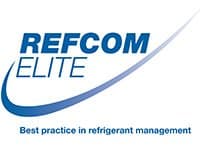In the past, many air conditioning systems relied on hydrochlorofluorocarbon (HCFC) refrigerants which we now know are responsible for depleting ozone in the atmosphere. This led to a weakening of the ozone layer which provides vital protection from harmful solar radiation. As a result, HCFC refrigerants such as the once standard R22 have been banned, meaning that older systems running on these refrigerants can no longer be topped up.
Many alternatives to R22 have been proposed and there is now a new option on the market, R32. With the UK now having seen its first installation of a system running on R32, we decided to take a look at the new refrigerant and see what the benefits are and whether it really is the ultimate replacement for R22.
What is R32?
R32 is a low global warming potential (GWP) hydrofluorocarbon (HFC) refrigerant. Unlike HCFCs, HFCs do not deplete ozone, however they do still contribute to global warming, but to a much smaller degree. R32’s chemical name is difluoromethane (methylene fluoride) and it has been commonly used for years in industry standard refrigerant blends such as R407C and R410A.
However, many manufacturers are now coming round to the idea of using systems which run on pure R32. This is because R32’s GWP is about a third that of conventional alternatives such as R410A.
How effective is R32?
According to research, pure R32 can perform around 6% more efficiently than the commonly used blended refrigerant R410A. This means not only is it less polluting, but an R32 system will also cost less to run.
Environmental Impact
As a single gas refrigerant, R32 should be easier to recycle when a cooling system comes to the end of its useful life, further reducing the lifetime environmental cost of an R32 system. Refrigerant blends such as R410A are currently relatively hard to recycle due to the need to separate out the different components.
The downsides of R32
The one real negative of R32 that does have to be considered is that it is mildly flammable. This is not an issue in refrigerant blends that contain R32 as the other gases prevent the R32 from igniting. If you are planning a system based on pure R32 extra steps (in particular safe handling) will need to be taken to account for the small risk of ignition. However, many now feel that the environmental and economic benefits of R32 significantly outweigh the slight increased flammability risk.
Total Environmental Kooling offers commercial air conditioning installation and maintenance throughout the UK. To find out more or to book a consultation call us now on 0117 952 3355.






